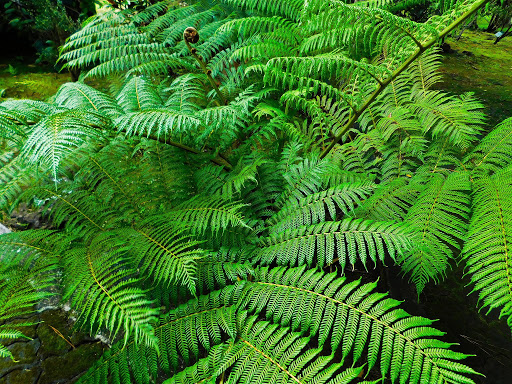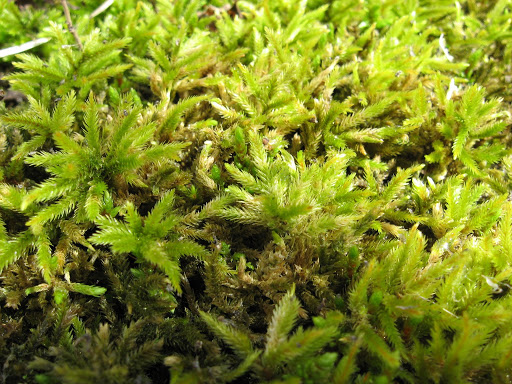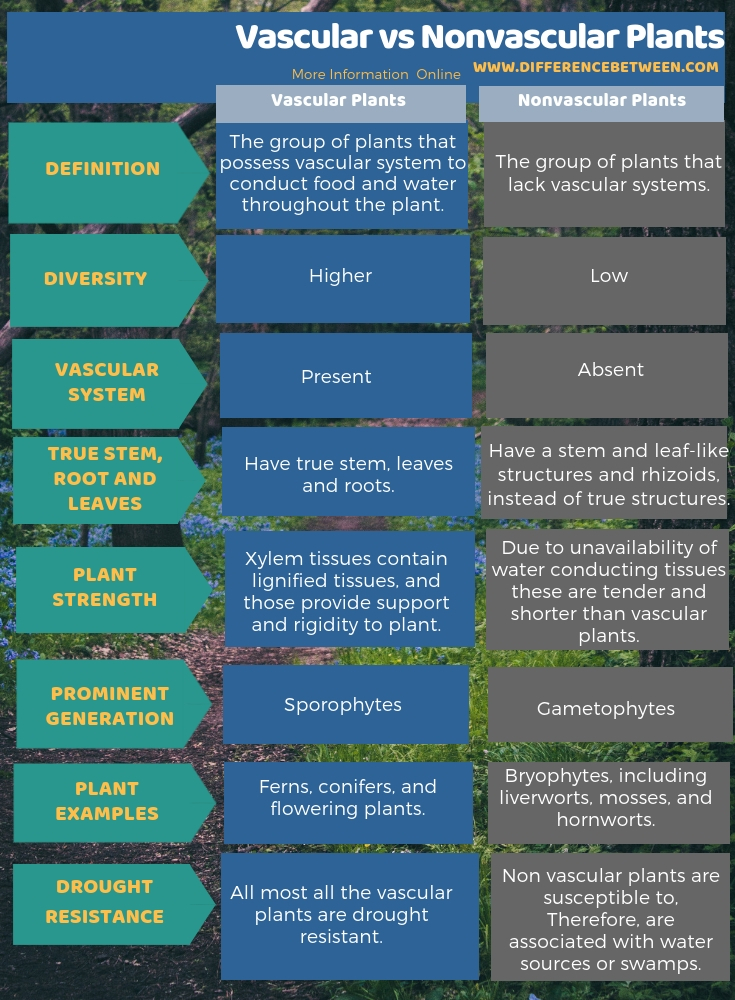Difference Between Vascular and Nonvascular Plants
The key difference between vascular and nonvascular plants is that the vascular plants have a vascular tissue to transport water, minerals and nutrients while the nonvascular plants do not have vascular tissue.
Kingdom Plantae is one of the five kingdoms in the classification system. It includes all green plants that are photosynthetic eukaryotes. Some are microscopic plants while some are big macroscopic trees. Plant kingdom could be divided into two major groups. They are vascular plants and non vascular plants. Though they look similar from the outside, there are many differences between vascular and non vascular plants. The primary difference between vascular and non vascular plants is the vascular tissue that composes xylem and phloem. Vascular system functions in transporting water and foods throughout the plant.
CONTENTS
1. Overview and Key Difference
2. What are Vascular Plants
3. What are Nonvascular Plants
4. Similarities Between Vascular and Nonvascular Plants
5. Side by Side Comparison – Vascular vs Nonvascular Plants in Tabular Form
6. Summary
What are Vascular Plants?
Vascular plants are the higher plants that belong to the plant group Tracheophyta. They consist of a highly specialized vascular system or the vascular tissue. Further, this vascular system comprises two major complex tissues such as phloem and xylem. These phloem and xylem are responsible for the translocation of nutrients and water respectively throughout the body. Also, the vascular tissues provide support and rigidity to the plant. There are lignified tissues associated with xylem that provide strength to the plants.

In plants, we can see a different combination of tissues that are developed well into the organs. Therefore, there are four main types of tissues found in vascular plants. They are vascular tissues, meristematic tissues, ground tissues and dermal tissues.
Besides, the principal generation phase of the vascular plant is sporophyte, which is diploid. Also, these plants comprise of true root systems, strong stem, leaves, etc. Vascular plants include ferns, conifers, and flowering plants. Moreover, the vascular plants could be either seed-bearing plants or spore-bearing plants. Also, the plants belong to this group have diverse and complex life cycles.
What are Nonvascular Plants?
Nonvascular plants are the plants that do not have vascular systems. They are lower plants. These plants do not contain xylem or phloem tissues. But they have special tissues for translocation of water. Bryophytes, including liverworts, mosses, and hornworts belong to nonvascular plant group. Since vascular tissues are absent in this group, they do not have a true stem, root system or leaves. Also, non vascular plants do not contain a wide variety of specialized tissues. Therefore, some plants in this group look like leaves (liverworts). Also, some plants have root-like structures, which are rhizoids. Gametophyte generation is prominent in nonvascular plants. Those gametophytes are haploids (contain a single set of a chromosome).

Since nonvascular plants lack water-conducting tissues, these plants cannot grow high. Also, these plants cannot tolerate drought. But, they can absorb water from the surrounding air or nearby sources through surface tissues. Habitats of these plants are swamps, bogs or near water sources. All types of plants in this group have a uniform life cycle.
What are the Similarities Between Vascular and Nonvascular Plants?
- Vascular and Nonvascular Plants are green plants belonging to kingdom Plantae.
- They are photoautotrophic, thus, can affect photosynthesise.
What is the Difference Between Vascular and Nonvascular Plants?
Vascular plants are higher plants that have true stem, roots and leaves. Furthermore, they have a vascular system to transport nutrients, water and minerals throughout the plant. In contrast, nonvascular plants are lower plants which do not have a vascular system. Therefore, this is the key difference between vascular and nonvascular plants. Furthermore, nonvascular plants lack true stem, roots and leaves. Another difference between vascular and nonvascular plants is that the vascular plants can live in any harsh environmental conditions while the nonvascular plants need water to complete their life cycles.
The below infographic tabulates more details on the difference between vascular and nonvascular plants.

Summary – Vascular vs Nonvascular Plants
Vascular and nonvascular plants are two types of plants in the kingdom Plantae. The major difference between vascular and nonvascular plants is that the vascular plants have a vascular system to transport foods and water while the nonvascular plants lack with the vascular tissues. Hence, nonvascular plants are not as strong as vascular plants. They are small and simple plants. Furthermore, they reside in the habitats that have enough moisture. On the other hand, vascular plants are higher plants, and they are rigid trees. They have true stem, roots and leaves. This is the difference between vascular and nonvascular plants.
Reference:
1.Study.com, Study.com. Available here
2.Britannica, The Editors of Encyclopaedia. “Tracheophyte.” Encyclopædia Britannica, Encyclopædia Britannica, Inc., 23 July 2018. Available here
Image Courtesy:
1.”1198645″ (CC0) via pxhere
2.”1260006″ (CC0) via pxhere
ncG1vNJzZmivp6x7pbXFn5yrnZ6YsqOx07CcnqZemLyue8OinZ%2Bdopq7pLGMm5ytr5Wau27CwKyarqSRp3qiusNmraxlnqS7t63SnKylmaJiva2tza2qaA%3D%3D